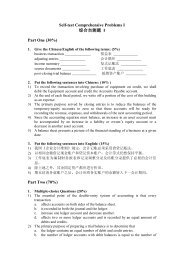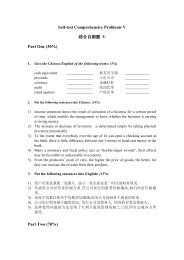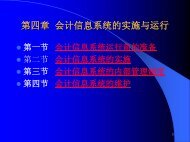Vodafone Group Plc Annual Report for the year ended 31 March 2012
Vodafone Group Plc Annual Report for the year ended 31 March 2012
Vodafone Group Plc Annual Report for the year ended 31 March 2012
Create successful ePaper yourself
Turn your PDF publications into a flip-book with our unique Google optimized e-Paper software.
<strong>Vodafone</strong> <strong>Group</strong> <strong>Plc</strong><br />
<strong>Annual</strong> <strong>Report</strong> <strong>2012</strong><br />
115<br />
Year <strong>ended</strong> <strong>31</strong> <strong>March</strong> 2010<br />
The net impairment loss was based on value in use calculations. The pre-tax adjusted discount rates used in <strong>the</strong> value in use calculation in <strong>the</strong> <strong>year</strong><br />
<strong>ended</strong> <strong>31</strong> <strong>March</strong> 2010 were as follows:<br />
Pre-tax adjusted<br />
discount rate<br />
India 13.8%<br />
Turkey 17.6%<br />
During <strong>the</strong> <strong>year</strong> <strong>ended</strong> <strong>31</strong> <strong>March</strong> 2010 <strong>the</strong> goodwill in relation to <strong>the</strong> <strong>Group</strong>’s operations in India was impaired by £2,300 million primarily due to<br />
intense price competition following <strong>the</strong> entry of a number of new operators into <strong>the</strong> market. The pre-tax risk adjusted discount rate used in <strong>the</strong><br />
previous value in use calculation at <strong>31</strong> <strong>March</strong> 2009 was 12.3%.<br />
In addition, impairment losses of £200 million, previously recognised in respect of intangible assets in relation to <strong>the</strong> <strong>Group</strong>’s operations in Turkey,<br />
were reversed. The reversal was in relation to licences and spectrum and was as a result of favourable changes in <strong>the</strong> discount rate. The cash flow<br />
projections within <strong>the</strong> business plans used <strong>for</strong> impairment testing were substantially unchanged from those used at <strong>31</strong> <strong>March</strong> 2009. The pre-tax risk<br />
adjusted discount rate used in <strong>the</strong> previous value in use calculation at <strong>31</strong> <strong>March</strong> 2009 was 19.5%.<br />
Goodwill<br />
The carrying value of goodwill at <strong>31</strong> <strong>March</strong> was as follows:<br />
<strong>2012</strong> 2011<br />
£m £m<br />
Germany 11,566 12,200<br />
Italy 10,400 13,615<br />
Spain 5,833 7,133<br />
27,799 32,948<br />
O<strong>the</strong>r 10,551 12,288<br />
38,350 45,236<br />
Key assumptions used in <strong>the</strong> value in use calculations<br />
The key assumptions used in determining <strong>the</strong> value in use are:<br />
Assumption<br />
How determined<br />
Budgeted EBITDA<br />
Budgeted EBITDA has been based on past experience adjusted <strong>for</strong> <strong>the</strong> following:<br />
aa<br />
voice and messaging revenue is expected to benefit from increased usage from new customers, especially<br />
in emerging markets, <strong>the</strong> introduction of new services and traffic moving from fixed networks to mobile<br />
networks, though <strong>the</strong>se factors will be offset by increased competitor activity, which may result in price<br />
declines, and <strong>the</strong> trend of falling termination and o<strong>the</strong>r regulated rates;<br />
aa<br />
non-messaging data revenue is expected to continue to grow as <strong>the</strong> penetration of 3G (plus 4G where<br />
available) enabled devices and smartphones rise along with higher data bundle attachment rates, and<br />
new products and services are introduced; and<br />
aa<br />
margins are expected to be impacted by negative factors such as <strong>the</strong> cost of acquiring and retaining<br />
customers in increasingly competitive markets and <strong>the</strong> expectation of fur<strong>the</strong>r termination rate cuts<br />
by regulators and by positive factors such as <strong>the</strong> efficiencies expected from <strong>the</strong> implementation of<br />
<strong>Group</strong> initiatives.<br />
Budgeted capital expenditure The cash flow <strong>for</strong>ecasts <strong>for</strong> capital expenditure are based on past experience and include <strong>the</strong> ongoing capital<br />
expenditure required to roll out networks in emerging markets, to provide enhanced voice and data products<br />
and services and to meet <strong>the</strong> population coverage requirements of certain of <strong>the</strong> <strong>Group</strong>’s licences. Capital<br />
expenditure includes cash outflows <strong>for</strong> <strong>the</strong> purchase of property, plant and equipment and computer software.<br />
Long-term growth rate<br />
For businesses where <strong>the</strong> five <strong>year</strong> management plans are used <strong>for</strong> <strong>the</strong> <strong>Group</strong>’s value in use calculations, a<br />
long-term growth rate into perpetuity has been determined as <strong>the</strong> lower of:<br />
aa<br />
<strong>the</strong> nominal GDP rates <strong>for</strong> <strong>the</strong> country of operation; and<br />
aa<br />
<strong>the</strong> long-term compound annual growth rate in EBITDA in <strong>year</strong>s six to ten estimated by management.<br />
Pre-tax risk adjusted discount rate The discount rate applied to <strong>the</strong> cash flows of each of <strong>the</strong> <strong>Group</strong>’s operations is generally based on <strong>the</strong> risk free<br />
rate <strong>for</strong> ten <strong>year</strong> bonds issued by <strong>the</strong> government in <strong>the</strong> respective market. Where government bond rates<br />
contain a material component of credit risk, high quality local corporate bond rates may be used.<br />
These rates are adjusted <strong>for</strong> a risk premium to reflect both <strong>the</strong> increased risk of investing in equities and <strong>the</strong><br />
systematic risk of <strong>the</strong> specific <strong>Group</strong> operating company. In making this adjustment, inputs required are <strong>the</strong><br />
equity market risk premium (that is <strong>the</strong> required increased return required over and above a risk free rate by an<br />
investor who is investing in <strong>the</strong> market as a whole) and <strong>the</strong> risk adjustment, beta, applied to reflect <strong>the</strong> risk of <strong>the</strong><br />
specific <strong>Group</strong> operating company relative to <strong>the</strong> market as a whole.<br />
In determining <strong>the</strong> risk adjusted discount rate, management has applied an adjustment <strong>for</strong> <strong>the</strong> systematic risk to<br />
each of <strong>the</strong> <strong>Group</strong>’s operations determined using an average of <strong>the</strong> betas of comparable listed mobile<br />
telecommunications companies and, where available and appropriate, across a specific territory. Management<br />
has used a <strong>for</strong>ward-looking equity market risk premium that takes into consideration both studies by<br />
independent economists, <strong>the</strong> average equity market risk premium over <strong>the</strong> past ten <strong>year</strong>s and <strong>the</strong> market risk<br />
premiums typically used by investment banks in evaluating acquisition proposals.<br />
Business review Per<strong>for</strong>mance Governance Financials Additional in<strong>for</strong>mation






